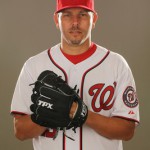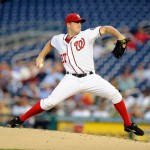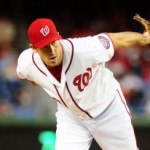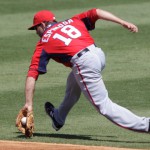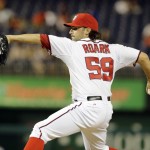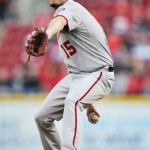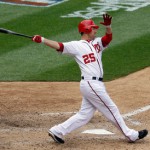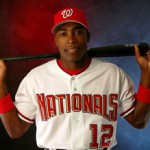
Remember when the team took this guy to Arbitration? Photo: Nats official photo day via deadspin.com
Just as the optimism of the new baseball season begins to flourish every February, as pitchers and catchers report and fans start to get excited for the newseason, some teams and players get to experience one of the more unpleasant realities of the modern baseball game; Arbitration hearings.
The 2013 “arbitration season” was the first since 1974 that didn’t feature a single case of player versus club, perhaps a sign that teams are finally understanding just how damaging these cases can be. Players are forced to sit and listen to their clubs argue just how mediocore or awful they are just to save (in some cases) a few hundred thousand dollars. The teams use whatever statistical slant they need to prove or disprove their points, depend heavily on out-dated/old school stats (Wins, Saves, RBI) to make their cases, and generally speaking do their best to save a buck. I read an example of a catcher who was in the top 10 in the league in batting and mentioned that as a stat in his favor, only to watch the team pull out a COMPLETE list of catchers (including guys who had like 10 at-bats) and show that the player wasn’t even in the top HALF of hitting for catchers. And the team representative stated it with a straight face. Meanwhile, these same teams generally have no issues signing veteran guys to multi-million dollar salaries to serve as middle relievers, backup outfields or 5th starters. It seems like a completely demoralizing process and I’m surprised teams even come close to arguing with their players any longer.
However, as it stands now there’s a whole slew of potential cases out there where players and clubs couldn’t come to an agreement ahead of the Jan 17th 2014 deadline. None more important than the Nats two open cases with Tyler Clippard and newly acquired Doug Fister.
Thanks to Maury Brown of the bizofbaseball.com blog, who keeps fantastic notes on Arbitration case results over the years for the core of the data that I used to make this post. This link shows all the argued cases from 2005 to 2012 and this link shows the settled cases to 2011 (needs updating; mlbtraderumors also keeps similar information that is up-to-date for 2012, 2013 and 2014).
Commenter Luke S. asked whether there was a relationship between teams who took their players to arguments and eventual retention. I thought that was a fascinating question, so I did some digging. Borrowing from Brown’s aforementioned links and then adding in some “player disposition” information, I’ve created an XLS (uploaded to Google Docs here and added to the NAR creation links to the right) that tracks all arbitration cases going back to 2005 with the disposition results. I’ve cut and pasted the core of the data here (leaving out the salaries and the description of what happened to the player).
| Year | Team | Player | Delta | Winner | Still with club? | Depart club THAT year? |
| 2012 | Miami | Anibal Sanchez | $1,100,000 | Player | No | Yes |
| 2012 | Washington | John Lannan | $700,000 | Club | No | Yes |
| 2012 | Milwaukee | Jose Veras | $375,000 | Club | No | Yes |
| 2012 | Miami | Emilio Bonifacio | $250,000 | Player | No | Yes |
| 2012 | Baltimore | Brad Bergesen | $400,000 | Club | No | Yes |
| 2012 | Tampa Bay | Jeff Niemann | $450,000 | Club | No | No |
| 2012 | Pittsburgh | Garrett Jones | $250,000 | Club | No | No |
| 2011 | Houston | Hunter Pence | $1,750,000 | Player | No | Yes |
| 2011 | Pittsburgh | Ross Ohlendorf | $625,000 | Player | No | Yes |
| 2011 | Los Angeles Angels | Jered Weaver | $1,435,000 | Club | Yes | No |
| 2010 | Miami | Cody Ross | $250,000 | Player | No | Yes |
| 2010 | Chicago Cubs | Ryan Theriot | $800,000 | Club | No | Yes |
| 2010 | Washington | Brian Bruney | $350,000 | Club | No | Yes |
| 2010 | Houston | Wandy Rodriguez | $2,000,000 | Club | No | No |
| 2010 | Milwaukee | Corey Hart | $650,000 | Player | No | No |
| 2010 | Tampa Bay | BJ Upton | $300,000 | Club | No | No |
| 2010 | Los Angeles Angels | Jeff Mathis | $600,000 | Player | No | No |
| 2010 | Washington | Sean Burnett | $150,000 | Club | No | No |
| 2009 | Washington | Shawn Hill | $275,000 | Player | No | Yes |
| 2009 | Miami | Dan Uggla | $950,000 | Player | No | No |
| 2009 | Tampa Bay | Dioner Navarro | $400,000 | Club | No | No |
| 2008 | Los Angeles Angels | Francisco Rodriguez | $2,500,000 | Club | No | Yes |
| 2008 | Colorado | Brian Fuentes | $1,450,000 | Club | No | Yes |
| 2008 | Washington | Felipe Lopez | $300,000 | Club | No | Yes |
| 2008 | Houston | Mark Lorretta | $2,150,000 | Club | No | Yes |
| 2008 | Philadelphia | Ryan Howard | $3,000,000 | Player | Yes | No |
| 2008 | New York Mets | Oliver Perez | $1,775,000 | Player | No | No |
| 2008 | Houston | Jose Valverde | $1,500,000 | Club | No | No |
| 2008 | New York Yankees | Chien-Ming Wang | $600,000 | Club | No | No |
| 2007 | Miami | Miguel Cabrera | $700,000 | Player | No | Yes |
| 2007 | San Diego | Todd Walker | $1,200,000 | Player | No | Yes |
| 2007 | Washington | John Patterson | $1,000,000 | Club | No | Yes |
| 2007 | Washington | Chad Cordero | $500,000 | Player | No | No |
| 2007 | Los Angeles Dodgers | Joe Beimel | $337,500 | Club | No | No |
| 2007 | Tampa Bay | Josh Paul | $315,000 | Club | No | No |
| 2007 | Miami | Kevin Gregg | $125,000 | Club | No | No |
| 2006 | Washington | Alfonso Soriano | $2,000,000 | Club | No | Yes |
| 2006 | Baltimore | Rodrigo Lopez | $750,000 | Club | No | Yes |
| 2006 | Minnesota | Kyle Lohse | $550,000 | Player | No | Yes |
| 2006 | Colorado | Sun-Woo “Sunny” Kim | $200,000 | Club | No | Yes |
| 2006 | Kansas City | Emil Brown | $375,000 | Player | No | No |
| 2006 | Tampa Bay | Josh Paul | $275,000 | Club | No | No |
| 2005 | Oakland | Juan Cruz | $260,000 | Club | No | Yes |
| 2005 | Minnesota | Kyle Lohse | $250,000 | Player | No | No |
| 2005 | Kansas City | Jeremy Affeldt | $250,000 | Club | No | No |
Now, thanks to some pivot table work in XLS and some other interesting analysis, here’s what we can glean from the 45 cases that have been argued going back to 2005:
- Clubs are 28/45 (62%), players are 17/45 (38%) in the last nine years of cases. Per Brown’s overall stats, Clubs hold a 291-214 lead in these cases historically, a 57% success rate, meaning the clubs are getting better at these hearings over the past decade or so.
- Washington is the leading “arguing” club with 8 of 45 cases since 2005. This is not a category with which we want to be a leader. I attribute a lot of these cases to an antagonistic former GM (Jim Bowden) who had no issues going to war over relatively small amounts, coupled with a new owner who had a very bad reputation for penny pinching in the early years of his tenure. That doesn’t absolve Mike Rizzo though; he’s already had 3 cases argued in his four seasons of management.
- 42% of all cases since 2005 by just 3 clubs (Washington, Miami and Tampa). The two Florida clubs are both notorious for squeezing money, albeit for different alleged reasons. Miami because their owner is well established as being in the game for the money, and Tampa because they’ve long since established the revenue issues their stadium situation places on the franchise.
- 12 of 30 clubs in the game have not had an arb argument/case dating to 2005. To me, this means 12 of the 30 clubs have figured out that $200,000 isn’t worth destroying a player’s ego.
- Smallest amount argued over: $125k by Miami in 2007 and $150K by Wash in 2010 w/ Sean Burnett. Again, no real surprise here that Miami went to arguments over $125k.
- Largest amount argued over: $3M by Philadelphia w/ Ryan Howard (player won)
- Biggest player demand: Francisco Rodriguez $12,500,000 (player lost).
- Biggest club offer ($10M twice; both club wins). One of these was Washington’s Alfonso Soriano case in 2006.
So, based on these numbers, lets think about the two cases Washington may have pending. The amount delta with Washington’s two 2014 cases is $3M with Fister and $1.9M with Clippard. So for comparison purposes, the $3M delta with Fister would tie the largest ever delta argued before the court. The $1.9M delta with Clippard is large as well, in the top 5 deltas ever taken to arbitration. Clearly, the team and these players have some serious work to do. Clippard is seemingly in more jeopardy of losing an arbitration case, thanks to his “demotion” and sudden lack of save opportunities. The fact that he is easily argued as our best reliever and has some of the best BAA/BABIP stats in the league is meaningless; no saves means less money in front of the panel. And what a welcome to the organization it would be for Fister to arrive and before throwing a pitch in anger having to hear how crummy a pitcher he is. I feel its vital to clear these cases up, extend the guys, do whatever you have to do in order to avoid the arbitration hearing.
Lastly, here’s a couple of interesting player retention stats related to those who go to arbitration:
- Just 2 of 45 players who have argued arb cases remain with their teams to this day; Jered Weaver and Ryan Howard. That seems like an awfully small number until you consider the nature of player movement in the game. The fact of the matter is this; players are constantly on the move in baseball, especially once they hit arbitration age where their salaries quickly overshadow their value. Teams have no issues employing pre-arb guys who are replacement level players. But once their salaries start jumping up and you have ready made replacements in AAA who cost 1/3rd or 1/4th as much as a 2nd or 3rd year arbitration player, it becomes pretty easy to trade, non-tender or DFA the near replacement level guy. So while it seems natural to think that players who argue with their teams are more apt to leave … I think perhaps its more common for guys to just end up leaving thanks to the huge churn and burn that exists at the back end of rosters.That being said, I’m sure something could be gleaned by doing this same “disposition analysis” for the 100s of players who settled their arbitration cases without hearings … but that’s just far too large a project for today’s little blog entry.
- Here is something rather interesting though: 23 of 45 players who argued w/ their clubs were traded or released THAT same season. Including a number of the Nationals argued cases. John Lannan lost his arb case in 2012, was relegated to AAA and was non-tendered. Bruney was released just two months into the 2010 season. Both Shawn Hill and John Patterson were cut in spring training before their salaries could even kick in. Felipe Lopez moped his way into a July release the summer after his hearing. And generally speaking about half of all players who had arguments ended up in new organizations either during or just after the season in which they argued with their teams. Is this a statement about player-club relations?
Anyway; just some interesting Arbitration Case stuff for you this cold January friday day. Extend Fister! Sign Clippard! Don’t go to hearings!
